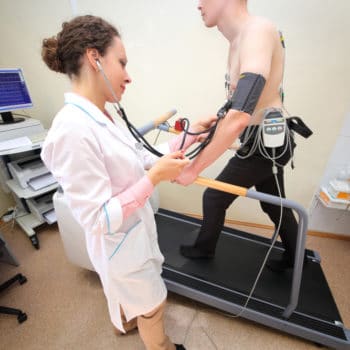Why We Love It
-
$192,120Potential Avg. Salary
-
10.2%Job Growth Rate
-
Growing DemandJob Outlook
-
Growing IndustryCareer Attribute
General practitioners are doctors who care for the basic needs of patients. Generally working as primary care or urgent care doctors, general practitioners perform annual physicals, conduct routine health screenings, treat illnesses, and refer patients to specialists when advanced care or testing is required.
Recommended Schools
What is a General Practitioner?
The following job responsibilities are common for individuals in general practitioner roles:
- Test and treat patients for illnesses and injuries
- Perform annual physicals and routine tests to evaluate a patient’s overall health
- Prescribe medications and take samples to be used in laboratory tests
- Refer patients to specialty providers when required
- Update and maintain patient medical records
A Day in the Life
General practitioners are doctors who often work as primary care physicians or urgent care doctors. As generalists, general practitioners are able to treat patients for a variety of conditions, illnesses, and injuries. They must recognize signs of trouble and prescribe the correct treatment, or refer patients to specialists when more advanced care is needed. General practitioners often have a set of patients that they care for over the course of their lives, treating some patients from their teenage to senior years.
General practitioners care for both ill and healthy patients. When patients are healthy, they visit their general practitioner yearly for an annual physical and any routine lab work. The general practitioner discusses any health concerns with the patients, offer wellness guidance, and conducts a series of tests designed to detect issues before they’ve progressed too far. When patients are ill, they may visit either their primary care physician or an urgent care provider. The general practitioner diagnoses the patients and prescribes a treatment if needed.
General practitioners are able to treat a variety of conditions. They can prescribe medications to treat patients for many conditions, from sinus infections to depression. They can also treat issues like broken bones by x-raying patients and applying casts. Because they’re often the first doctor to see patients when a health issue arises, general practitioners must be familiar with a diverse variety of diseases, conditions, and issues in order to recognize and provide the right care or referral to patients.
Typical Work Schedule
Most general practitioners work full-time schedules, and overtime is common in this line of work. Those that work as primary care physicians often keep regular business hours, but they may need to be available in evenings, on weekends, and outside of normal business hours for emergencies. Those that work in urgent care may have irregular schedules, working evenings, weekends, and even overnight shifts.
Projected Job Growth
Demand for general practitioners is expected to grow in the coming decade as a result of increased access to medical care among the general population, as well as the demands of an aging Baby Boomer population who will need increased care as they move into their senior years.
Typical Employers
Most general practitioners work in private offices, either self-owned or shared with one or more other providers. Some also work for hospitals and urgent care centers, providing one-time care for ill or injured patients.
Recommended Schools
How To Become a General Practitioner
The first step in becoming a general practitioner is to earn a bachelor’s degree. While your major as an undergraduate is flexible, you’ll want to make sure to take courses in biology, chemistry, math, and physics. If a premed major is available, it’s ideal, but if it’s not, it’s not critical. Most premed students major in the biological, social, and physical sciences. The most important thing is that you take the required classes for admission into medical school and earn high grades in all of your courses.
After earning your bachelor’s degree, you’ll need to take the MCAT—a standardized test for aspiring medical school students—and begin applying for medical school. Admission to medical schools can be competitive, so it’s important to have excellent grades, a high score on the MCAT, compelling letters of recommendation, and a record of participation in extracurricular activities. If you feel your qualifications are lacking, it may be to your advantage to pursue a master’s degree before applying to medical school.
Medical school is a graduate, professional program that lasts approximately four years. The first two years are spent in classroom study, and the last two are spent in residencies where you learn how to be a doctor by working for and observing experienced physicians. In medical school, you can earn an M.D. (Medical Doctor) or D.O. (Doctor of Osteopathic Medicine), though many general practitioners pursue D.O. degrees. To earn your license, you’ll need to complete medical school and pass the required exam.
General Practitioner Salary Data
We’ve provided you the following to learn more about this career. The salary and growth data on this page comes from recently published Bureau of Labor Statistics data while the recommendations and editorial content are based on our research.
National Anual Salary
Low Range
$130,560Average
$192,120High Range
---National Hourly Wage
Low Range
$63/hrAverage
$92/hrHigh Range
---How do General Practitioner salaries stack up to other jobs across the country? Based on the latest jobs data nationwide, General Practitioner's can make an average annual salary of $192,120, or $92 per hour. On the lower end, they can make $130,560 or $63 per hour, perhaps when just starting out or based on the state you live in.
Salary Rankings And Facts
#9 Nationally for All Careers
Above Average Salary Nationally
Programs and Degrees
Here are the most common degrees for becoming a General Practitioner. a is usually recommended and specifically a degree or coursework that prepares you for the particular field, see below.
Highest Education Among General Practitioners
- 93.7% Doctorate
- 3.3% Masters
- 2.3% Bachelors
- 0.3% Associates
- 0.1% College
- 0.2% High School
- 0.2% Less than High School
Job Growth Projections and Forecast
2014 Total Jobs
139,8002024 Est. Jobs
154,100Job Growth Rate
10.2%Est. New Jobs
14,300How does General Practitioner job growth stack up to other jobs across the country? By 2024, there will be a change of 14,300 jobs for a total of 154,100 people employed in the career nationwide. This is a 10.2% change in growth over the next ten years, giving the career a growth rate nationwide of Above Average.
Growth Rankings And Facts
#192 Nationally for All Careers
Above Avg. Growth Nationally
What Companies Employ The Most General Practitioners
| Industry | Current Jobs | New Jobs Needed | % Increase |
|---|---|---|---|
| Offices of physicians | 83,400 | 8,600 | 9% |
| General medical and surgical hospitals; private | 18,300 | -700 | -1% |
| Self-employed workers | 13,000 | 2,300 | 2% |















